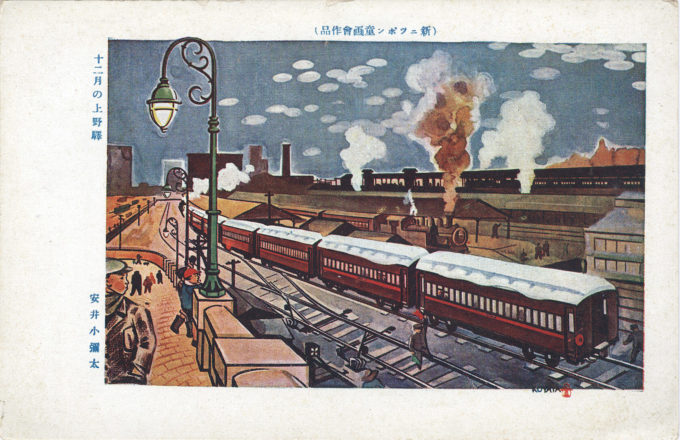
“Ueno Station in December”, Tokyo, c. 1930. A winning painting by Koyata Yasui of the New Japan Children’s Art Club. Ueno Station opened on July 28, 1883, connecting the Japanese capital with the mountain provinces to the west and to its most remote provinces in the north. The original wood one-story railway station was destroyed during the 1923 Great Kanto Earthquake and replaced with a multi-story concrete terminal.
See also:
Ueno Station, c. 1910-1920.
Ueno Station, c. 1930-1950.
“Only a year after the completion of the Shimbashi line [in 1872], the daimyo of the houses of Date, Ikeda, Hosokawa, Kamei, Mori, Matsudaira, and Yamanouchi petitioned the government for the right to build a railroad from Tokyo northward to Aomori, the most prominent town at the northern-most tip of Honshu. The petition was not granted.
“… In the period following the Satsuma Rebellion [in 1877], various nobles loyal to the government had also pressed for a charter to construct a railway … So it came to pass that in 1881, imperial assent was given to the charter of a corporation that had ambitiously been styled the Nippon Tetsudo Kaisha (‘Japan Railway Company’) by the nobles of the Imperial Court and former samurai who were promoting the scheme.
“… The route of the proposed line ran from Tokyo northward to Aomori at the northern tip of Honshu, serving the triple purpose of developing the Tohoku region, connecting it with the Kanto Plain, further cementing Hokkaido to the political comity of the realm so that no future Republics of Yezo would occur, and providing a bulwark against potential Russian colonial enroachments from the direction of Vladisvostok and the Sakhalin Islands.
“… On what was then the northern outskirts of Tokyo, a suitable site for a terminal was chosen at a park called Ueno, destined to become Ueno Station, the second principal railway station to be built in Tokyo.”
– Early Japanese Railways, 1863-1914: Engineering Triumphs That Transformed Meiji-era Japan, by Dan Free, 2008

